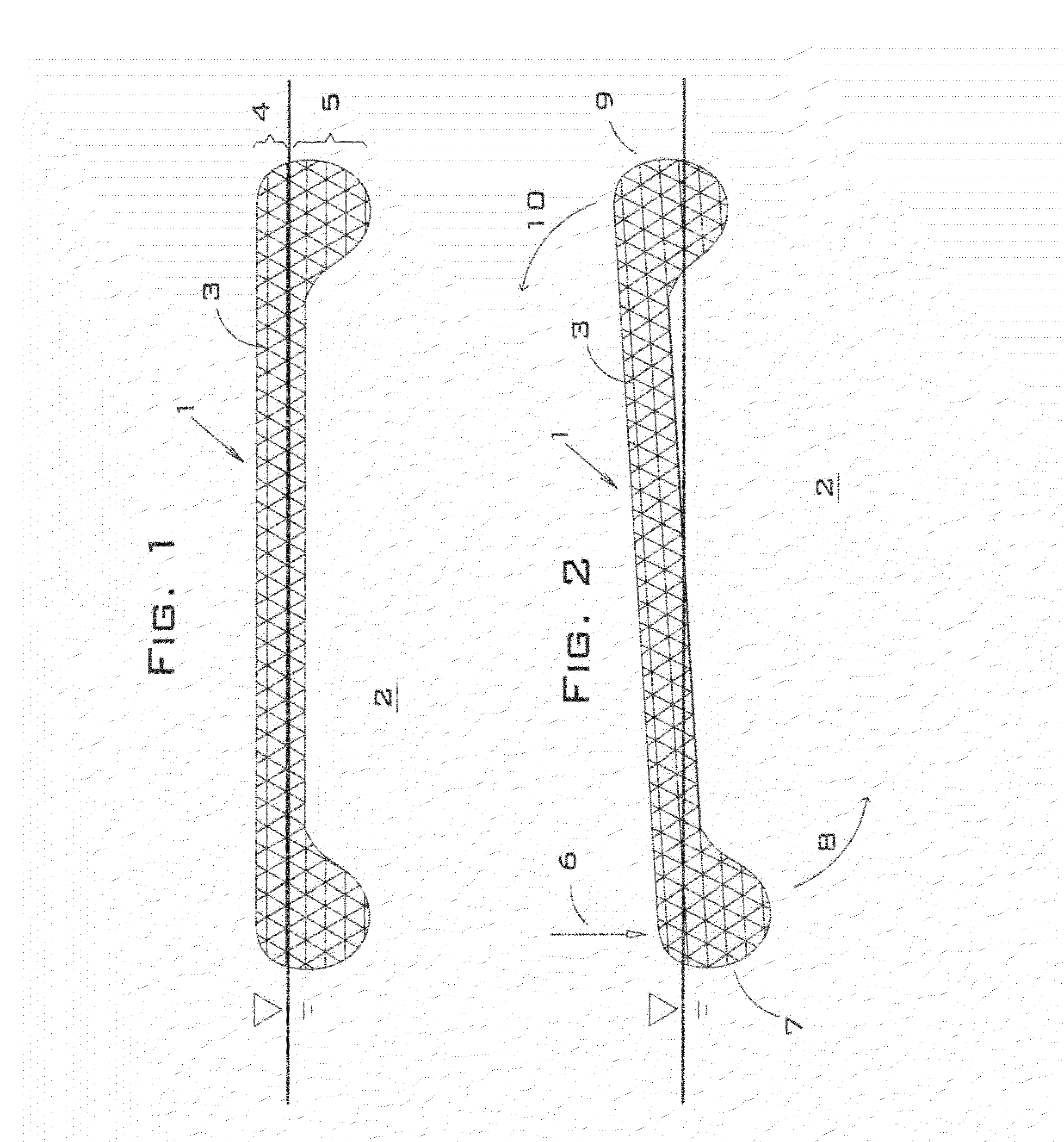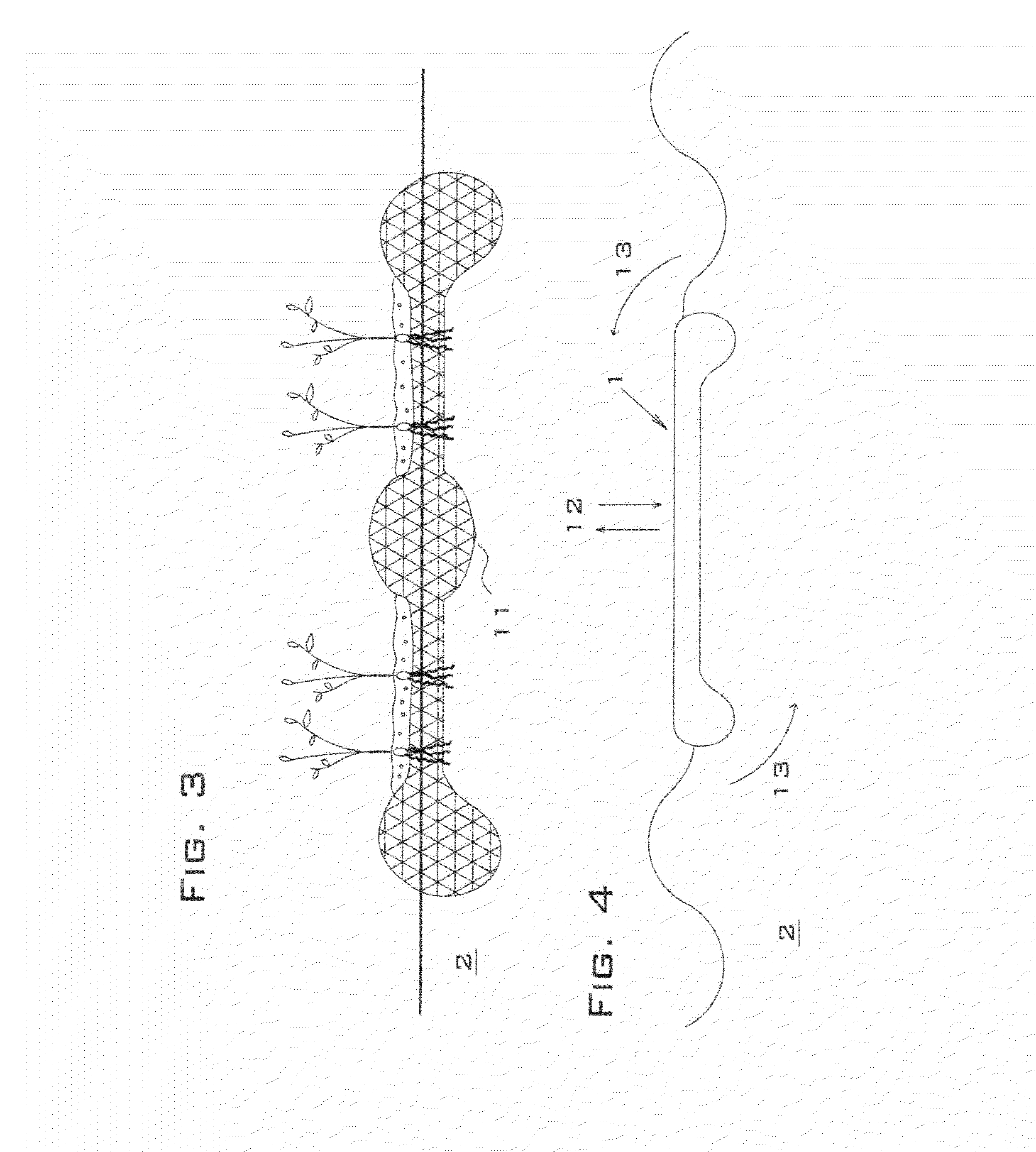Low-cost microbial habitat for water quality enhancement and wave mitigation
a microbial habitat and low-cost technology, applied in pisciculture, aquaria, marine site engineering, etc., can solve the problems of increasing the cost of manufacture and deployment, inherently unstable background art floating platforms, and excessive bob and rock of existing floating platforms, so as to achieve less material mass, less material cost, and enhanced stability
- Summary
- Abstract
- Description
- Claims
- Application Information
AI Technical Summary
Benefits of technology
Problems solved by technology
Method used
Image
Examples
first embodiment
[0187]In a first embodiment, a simulated coral reef is constructed from a buoyant polymer matrix structure that is anchored at or near the bottom of a water body. This embodiment may be advantageous for locations in which floating water-treatment structures are undesirable (for example, in zones of boat traffic). Although the simulated coral reefs may be constructed from either polymer (e.g., polyester, polyethylene, or polypropylene) or natural fibers (e.g., coir, jute, or tree branches), polymer materials are generally preferred over natural materials for biofilm substrates in natural water systems because natural fibers provide a source of organic carbon for microbial biofilms that grow on the fibers, and the biofilm communities growing on natural materials tend to be dominated by microbes (such as bacteria) that require organic carbon for metabolism. When these microbes metabolize the organic carbon in the natural fibers, they also uptake dissolved oxygen from the water and disc...
second embodiment
[0196]A second embodiment is shown in FIG. 15. In this embodiment, a positively or negatively buoyant simulated coral structure 101 is fabricated from one or more pieces of polymer matrix 112 and / or one or more permeable bag units 113 that are strung together vertically via a connecting rod 111 that passes through each piece of polymer matrix 112 and / or permeable bag unit 113. The lower end of the connecting rod 111 is attached to an anchor assembly 103 that positions the simulated coral structure 101 above the water body bottom 102 at a pre-determined height.
[0197]Each piece of polymer matrix 112 may alternately be comprised of polyester fibers reinforced with latex binder or recycled carpet fibers bonded into a permeable mat. Each permeable bag unit 113 is comprised of a containment bag made of netting filled with scrap pieces of polymer matrix, loose polymer fibers, or a combination of scrap matrix and loose fibers. Each of the pieces of polymer matrix 112 and permeable bag units...
fourth embodiment
[0200]the present invention is shown in FIG. 17. In this embodiment, a weed blanket 116 is suspended above a lake bottom 102 by anchor weights 117 placed around the perimeter of the weed blanket 116. The weed blanket 116 shown in FIG. 17 is comprised of polymer fibers that are sandwiched between two layers of permeable fabric. Alternately, the weed blanket may be comprised of sheets of polymer matrix material (not shown). When the weed blanket 116 is installed over submerged aquatic plants 118, the weed blanket 116 prevents sunlight from reaching the plants 118 that are beneath the weed blanket 116, thereby causing these plants 118 to die and also preventing new plant growth. The weed blanket 116 may optionally be shaped so as to form a long, narrow bottom covering (for example, 15 feet wide by 100 feet long). This shape is particularly advantageous for providing weed-free pathways for boat traffic in lakes with prolific weed growth.
[0201]The weed blanket may be designed to be negat...
PUM
 Login to View More
Login to View More Abstract
Description
Claims
Application Information
 Login to View More
Login to View More - R&D
- Intellectual Property
- Life Sciences
- Materials
- Tech Scout
- Unparalleled Data Quality
- Higher Quality Content
- 60% Fewer Hallucinations
Browse by: Latest US Patents, China's latest patents, Technical Efficacy Thesaurus, Application Domain, Technology Topic, Popular Technical Reports.
© 2025 PatSnap. All rights reserved.Legal|Privacy policy|Modern Slavery Act Transparency Statement|Sitemap|About US| Contact US: help@patsnap.com



